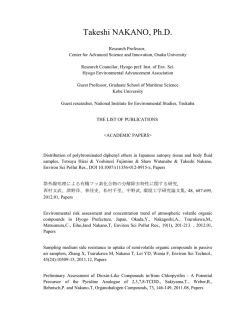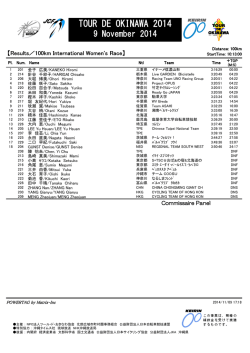
資料1-8 C-1028(PDF:142KB)
1 物質番号 通し番号 整理番号 MITI番号 CAS番号 物質名 英名 C-1028 205 123-31-9 ヒドロキノン Hydroquinone 2 発がん性分類 分類 機関名 評価年 結果 評価書引用文献 ●IARC (1977) IARC Monographs on the Evaluation of the Carcinogenic Risk of Chemicals to Man, Vol. 15, Some Fumigants, the Herbicides 2,4-D and 2,4,5-T, Chlorinated Dibenzodioxins and Miscellaneous Industrial Chemicals, Lyon, pp. 155–175 ●●Boylatld, E., Busby, E.R., Dukes, C.E., Grover, P.L. & Manson,D.(1964) Further experiments on implantation oof materials into the urinary bladder of mice. Brit.J.Cancer, 18, 5757-581 ●●Roe, F.J.C. E Salaman,M.H.(1955) Further studies on incomplete carcinogenesis: triethylene melamine(T.E.M.), 1,2-benzanthracene and β -propiolactone as initiators of skin turmour formation in the mouse. Brit.J.Cancer,9,177-203 IARC 3 1999 ●Hard, G.C., Whysner, J., English, J.C., Zang, E. & Williams, G.M. (1997) Relationship of hydroquinoneassociated rat renal tumors with spontaneous chronic progressive nephropathy.Toxicol. Pathol., 25, 132–143 ●Kari, F.W., Bucher, J., Eustis, S.L., Haseman, J.K. & Huff, J.E. (1992) Toxicity and carcinogenicity of hydroquinone in F344/N rats and B6C3F1 mice. Food chem. Toxicol., 30, 737–747 ●Miyata, Y., Fukushima, S., Hirose, M., Masui, T. & Ito, N. (1985) Short-term screening of promoters of bladder carcinogenesis in N-butyl-N-(4-hydroxybutyl)nitrosamine-initiated, unilaterally ureter-ligated rats. Jpn. J. Cancer Res. (Gann), 76, 828–834 ●Nielsen, H., Henriksen, L. & Olsen, J.H. (1996) Malignant melanoma among lithographers. Scand. J. Work Environ. Health., 22, 108–111 ●Okazaki, S., Hoshiya, T., Takahashi, S., Futakuchi, M., Saito, K. & Hirose, M. (1993) Modification of hepato-and renal carcinogenesis by catechol and its isomers in rats pretreated with N-ethyl-Nhydroxyethylnitrosamine. Teratog. Carcinog. Mutag., 13, 127–137 ●Pifer, J.W., Hearne, F.T., Swanson, F.A. & O’Donoghue, J.L. (1995) Mortality study of employees engaged in the manufacture and use of hydroquinone. Int. Arch. occup. environ. Health, 67, 267–280 ●Shibata, M.-A., Hirose, M., Tanaka, H., Asakawa, E., Shirai, T. & Ito, N. (1991) Induction of renal cell tumors in rats and mice, and enhancement of hepatocellular tumor development in mice after longterm hydroquinone treatment. Jpn. J. Cancer Res (Gann), 82, 1211–1219 ●Stenius, U., Warholm, M., Rannug, A., Walles, S., Lundberg, I. & Högberg, J. (1989) The role of GSH depletion and toxicity in hydroquinone-induced development of enzyme-altered foci. Carcinogenesis, 10, 595–599 ●United States National Toxicology Program (1989) Toxicology and Carcinogenesis Studies of Hydroquinone (CAS No. 123-31-9) in F344/N Rats and B6C3F1 Mice (Technical Report Series No. 366; NIH Publ. No. 90-2821), Research Triangle Park, NC ●Yamaguchi, S., Hirose, M., Fukushima, S., Hasegawa, R. & Ito, N. (1989) Modification by catechol and resorcinol of upper digestive tract carcinogenesis in rats treated with methyl-n-amylnitrosamine. Cancer Res., 49, 6015–5018 EPA × - - NTP × - - ●Boutwell R; Bosch D: The Tumor Promoting Action of Phenol and Related Compounds for Mouse Skin. Cancer Res 19:413–424 (1959). ●Boyland E; Busby ER; Dukes CE; et al.: Further Experiments on Implantation of Materials into the Urinary Bladder of Mice. Br J Cancer 18:575–581(1964). ●Carlson AJ; Brewer NR: Toxicity Studies on Hydroquinone. Proc Soc Exp Biol 84:684–688 (1953). ●English JC; Perry LG; Vlaovic M; et al.: Measurement of Cell Proliferation in the Kidneys of Fischer 344 and Sprague–Dawley Rats After Gavage Administration of Hydroquinone. Fund Appl Toxicol 23:397 –406(1994a). ●Hard GC; Whysner J; English JC; et al.: Relationship of hydroquinone-associated rat renal tumors with spontaneous chronic progressive nephropathy. Toxicol Pathol 25:132–143 (1997). ●Kari FW; Bucher J; Haseman JK; Huff JE: Letter to the Editor. Fd Chem Toxic 32:866–867 (1994). ●Lau SS; Monks TJ; Everitt JI; et al.: Carcinogenicity of a Nephrotoxic Metabolite of the “Nongenotoxic” Carcinogen Hydroquinone. Chem Res Toxicol 14:25– 33 (2001). ●McGregor D: Hydroquinone: An Evaluation of the Human Risks from its Carcinogenic and Mutagenic Properties. Critical Reviews in Toxicology 37:887–914 (2007). ●Monks TJ; Lau SS: Toxicology of Quinone-Thioethers. Crit Rev Toxicol 22(5/6):243–270 (1992). ACGIH A3 2008 産衛学 会 × - EU 3 - *1 ●National Toxicology Program (NTP): NTP Technical Report on the Toxicology and Carcinogenesis Studies of Hydroquinone (CAS No 123-31-9) in F344/N rats and B6C3F1 Mice (Gavage Studies). National Toxicology Program TR 366; National Institutes of Health. Pub No 90-2821. National Toxicology Program, Research Triangle Park, NC (1989). [Published as Kari FW; Bucher J; Eustis SL; et al.: Toxicity and Carcinogenicity of Hydroquinone in F344/N Rats and B6C3F1 Mice. Food Chem Toxicol 30:737–747 (1992). ●O’Donoghue JL; English JC: Letter to the Editor. Fd Chem Toxic 32:863–866 (1994). ●Roe FJC; Salaman MH: Further Studies on Incomplete Carcinogenesis: Triethylene Melamine (TEM), 1,2-Benzanthracene and $-Propiolactone as Initiators of Skin Tumour Formation in the Mouse. Br J Cancer 9:177–203 (1955). ●Shibata MA; Yamada M; Hirose M; et al.: Early Proliferative Responses of Forestomach and Glandular Stomach of Rats Treated with Five Different Phenolic Antioxidants. Carcinogenesis 11:425– 429 (1990). ●Shibata MA; Hirose M; Tanaka H; et al.: Induction of Renal Cell Tumors in Rats and Mice, and Enhancement of Hepatocellular Tumor Development in Mice After Long-Term Hydroquinone Treatment. Jpn J Cancer Res 82:1211–1219 (1991). ●Van Duuren BL; Goldschmidt BM: Cocarcinogenic and Tumor-Promoting Agents in Tobacco Carcinogenesis. J Natl Cancer Inst 56:1237–1242 (1976). ●Whysner J; Verna L; English JC; Williams GM: Analysis of studies related to tumorigenicity induced by hydroquinone. Regulatory Toxicology and Pharmacology 21:158–176 (1995). ●Yamaguchi S; Hirose M; Fukushima S; et al.: Modification by Catechol and Resorcinol of Upper Digestive Tract Carcinogenesis in Rats Treated with Methyl-N-Amylnitrosamine. Cancer Res 49:6015– 6018 (1989). - *1 *1 EU分類の根拠資料は公表されていない 3 発がん性に関する追加文献(動物試験、疫学調査) 追加文献の有無 不要 (1)動物試験 試験物質 試験 概要 試験 条件 #1 動物種 系統 試験の種類 ガイドライン GLP適用状況 試験 実施年 試験 実施者 動物数/ 性別/群 投与経路 用量/濃度 単位 投与/暴露期間 調査実 施年 調査実施者 発がん 影響 試験結 非発が 果概要 ん影響 結論 文献名 (2)疫学調査 調査の 種類 #1 文献名 調査方法 結果の概要
© Copyright 2026

